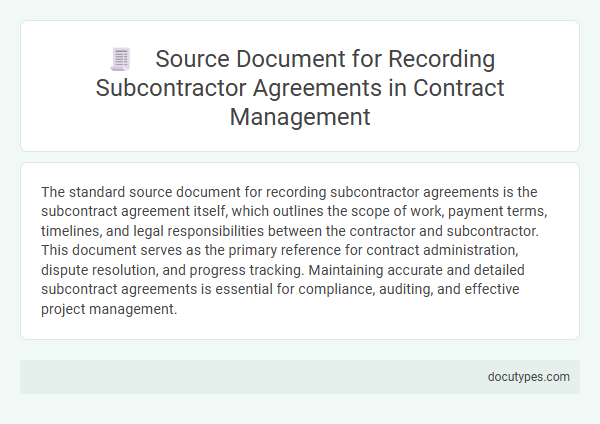The standard source document for recording subcontractor agreements is the subcontract agreement itself, which outlines the scope of work, payment terms, timelines, and legal responsibilities between the contractor and subcontractor. This document serves as the primary reference for contract administration, dispute resolution, and progress tracking. Maintaining accurate and detailed subcontract agreements is essential for compliance, auditing, and effective project management.
Introduction to Source Documents in Contract Management
In contract management, source documents serve as the primary evidence for recording agreements and transactions. They ensure accuracy and accountability in tracking contractual obligations.
The standard source document for recording subcontractor agreements is the subcontract agreement itself. This document outlines the scope, terms, payment schedules, and responsibilities between the contractor and subcontractor.
Importance of Recording Subcontractor Agreements
The standard source document for recording subcontractor agreements is the subcontract agreement itself, which details the scope of work, payment terms, and responsibilities. Accurate recording of this document is crucial for legal protection, clear communication, and project accountability. You ensure proper documentation preserves the rights of all parties and supports effective contract management throughout the project lifecycle.
Key Elements of a Subcontractor Agreement Source Document
| Element | Description |
|---|---|
| Parties Involved | Details of the main contractor and subcontractor including legal names and contact information. |
| Scope of Work | Clear description of tasks, services, or deliverables assigned to the subcontractor. |
| Contract Amount and Payment Terms | Agreed price for work, invoicing procedures, payment schedule, and milestones. |
| Duration and Timelines | Start date, completion date, and any critical deadlines or milestones. |
| Responsibilities and Obligations | Duties of both parties, compliance with laws, and quality standards expected from subcontractor. |
| Change Orders and Amendments | Procedures to modify the scope, cost, or timeline, including approvals required. |
| Insurance and Liability | Insurance requirements, liability limitations, and indemnification clauses protecting parties. |
| Termination Clauses | Conditions under which the agreement can be terminated by either party and consequences of termination. |
| Dispute Resolution | Mechanisms for resolving conflicts such as mediation, arbitration, or litigation processes. |
| Signatures and Dates | Authorized signatures from both parties and date of agreement execution. |
Types of Source Documents for Subcontractor Agreements
The standard source document for recording subcontractor agreements serves as the primary reference to formalize terms and obligations. Understanding the types of source documents helps ensure accurate contract management and compliance.
- Written Contracts - These are formal, signed agreements outlining the scope, payment terms, and responsibilities of subcontractors.
- Purchase Orders - Documents issued to initiate work, often including key subcontractor details and authorizations.
- Change Orders - Amendments to existing agreements that detail modifications in scope, cost, or schedule.
Your project documentation should always reference these source documents to maintain clarity and legal integrity in subcontractor relationships.
Document Control Procedures for Subcontractor Contracts
The standard source document for recording subcontractor agreements is the subcontractor contract itself. This document outlines the scope, terms, and conditions agreed upon by both parties.
Document control procedures for subcontractor contracts ensure accuracy, accountability, and traceability. Your organization must implement systematic filing, version tracking, and approval workflows to maintain contract integrity.
Compliance and Legal Considerations
The standard source document for recording subcontractor agreements is the subcontract agreement itself, which serves as the official contract between the primary contractor and subcontractor. This document ensures compliance with legal standards and contractual obligations, providing a clear framework for project scope, timelines, and payment terms.
- Subcontract Agreement - This legally binding document details the specific terms and conditions agreed upon by both parties.
- Compliance Verification - The subcontract agreement must adhere to local laws, industry regulations, and safety standards to avoid legal disputes.
- Audit and Record Keeping - Maintaining a signed subcontract agreement supports transparent record keeping and facilitates audits or claims resolution.
Best Practices for Documenting Subcontractor Relationships
The standard source document for recording subcontractor agreements is the subcontractor contract or agreement. This document outlines the terms, scope, and obligations between the main contractor and the subcontractor.
Best practices for documenting subcontractor relationships include clearly defining the scope of work, payment terms, and timelines within the agreement. Ensure all amendments or changes are recorded in writing to maintain clarity and legal protection. You should also keep signed copies securely stored for future reference or audits.
Integration with Contract Management Systems
What is the standard source document for recording subcontractor agreements? The standard source document for recording subcontractor agreements is the subcontractor contract or subcontract agreement. This document captures essential terms, scope of work, payment details, and compliance requirements, ensuring accurate integration with contract management systems for streamlined tracking and reporting.
Common Challenges in Managing Subcontractor Documentation
The standard source document for recording subcontractor agreements is the subcontract agreement itself, which outlines the terms, scope of work, and payment details. Proper management of these documents is critical to ensure compliance and avoid disputes.
- Inconsistent Documentation - Variations in subcontractor agreements often lead to misinterpretation and project delays.
- Poor Record Keeping - Failure to maintain organized and accessible records complicates audit processes and risk management.
- Compliance Issues - Missing or incomplete agreements can result in legal challenges and non-compliance with contractual obligations.
What Is the Standard Source Document for Recording Subcontractor Agreements? Infographic

